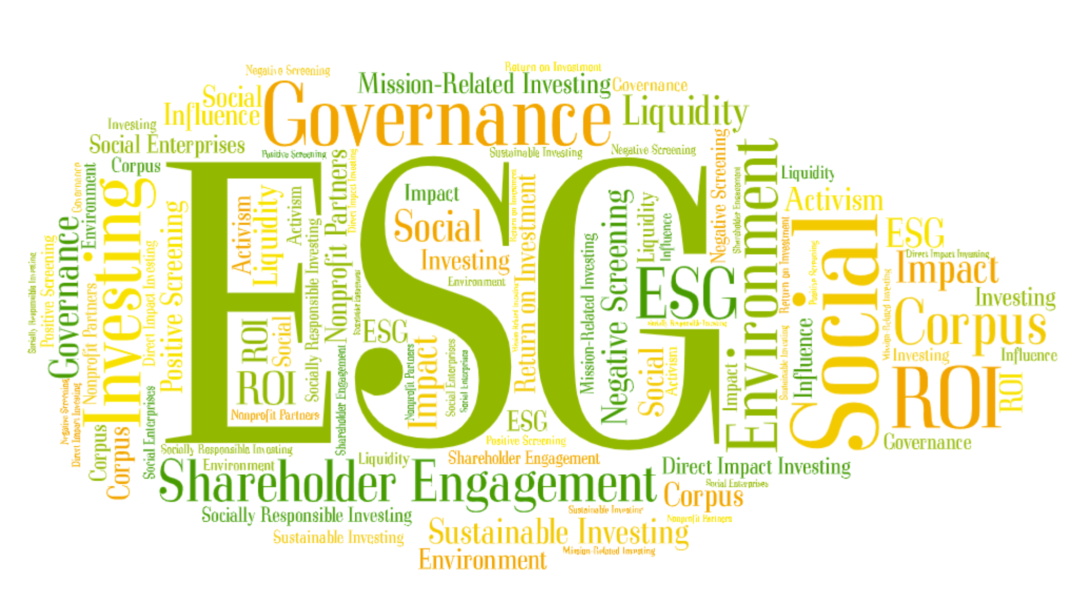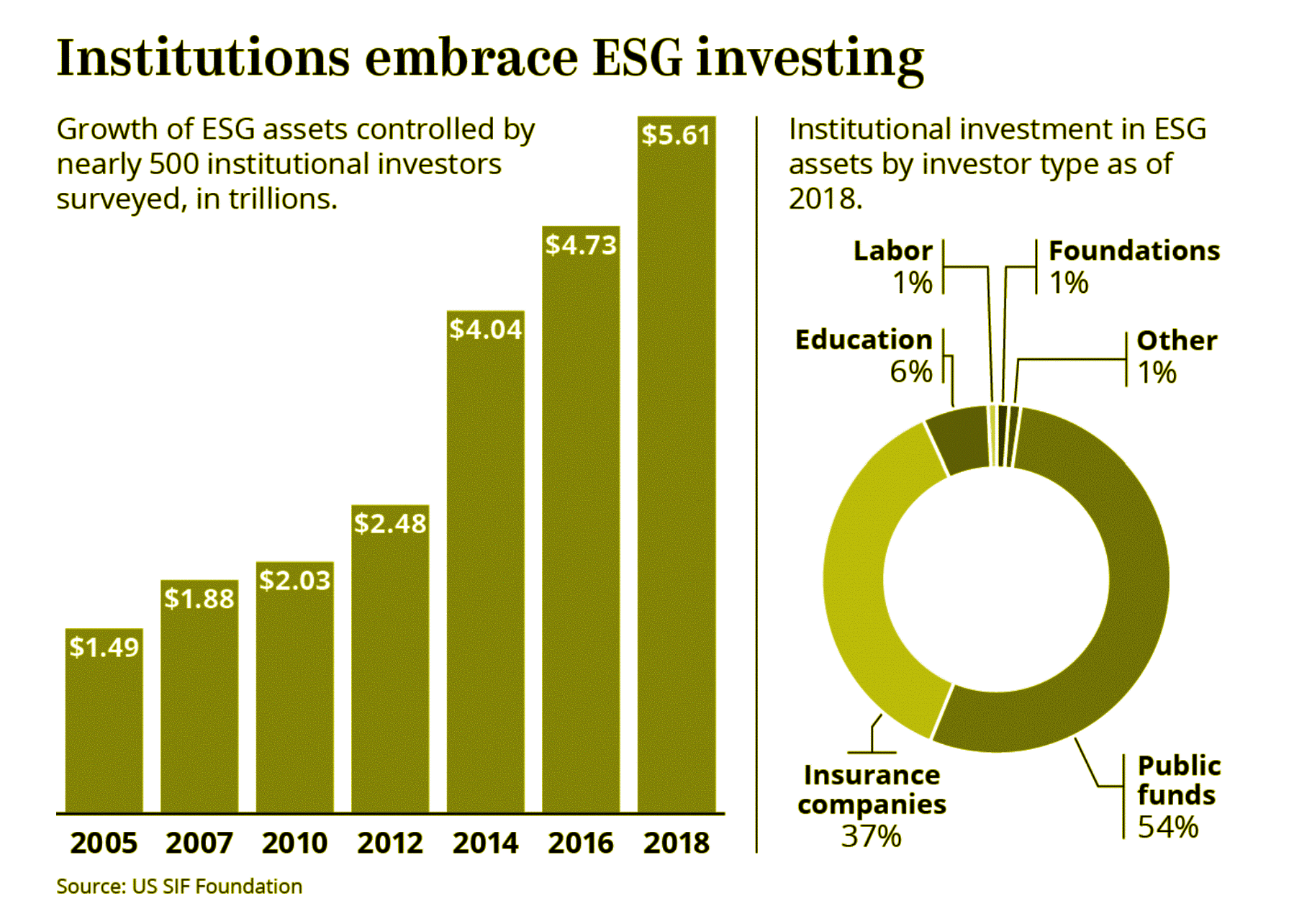ESG Investing: Making the Most of Your Foundation’s Assets
Categorized as: About us, Grantmaking strategy, Leadership, Poverty Alleviation, Social-impact investments, Stories on July 11, 2020.

Editor’s Note: Most people who work in or closely with foundations know about the 5% payout rule. This means that a foundation is required to spend 5% of their assets on foundation expenses, be that grants, staff salaries, general business expenses, etc. Considering what a small amount that is, our foundation has had a hard time sticking to this percentage. We are usually upwards of 7%, if not more.
You might ask, what about the other 95% (your corpus)? I asked the same question myself. If a foundation has $5 million, that means that $4.75 million isn’t doing a single thing! Some suggest that ESG investing is the way to go. However, if you’re like I was and don’t quite know what that means, fear not. There are only about a million definitions for it.
Over the past year and a half, this research has been my primary focus. I have learned the jargon, the spectrums, the differences in impact, and so much more. So while I am in no means an expert and a lot of this is open to interpretation, I will attempt to put a year of my research into a few short, digestible blogs for you lovely readers. This is the first part of a three-part series. Enjoy!
 By Bri Skees, Program Officer and VP of Research and Data Management
By Bri Skees, Program Officer and VP of Research and Data Management
E(Environmental) S(Social) G(Governance): Huh?
You might be wondering, what exactly is ESG data and how can you find it? Well, here is a short clip that explains everything!
Moving Your Assets to ESG Investments
ESG investing has been called many things, including Socially Responsible Investing (SRI), Mission-Related Investing (MRI), and Impact Investing. And while generally these are all under the same umbrella, they aren’t entirely the same thing. For the purpose of this blog, we will most closely relate ESG investing with sustainable investing. Confused yet? Let me explain.
When you have a huge chunk of money, you invest it, and the money you earn in interest is what you use to run your foundation. Your ROI (Return on Investment, aka the money you make on your investments) fluctuates year to year based on what the market is doing, but will hopefully average out to about 5-7% a year. So, if there is a foundation with $5 million in assets, they will earn about $250,000 a year and are also required to spend $250,000 a year (that 5% rule), with the goal being to remain at about the same asset size overall, or to grow. So, while the foundation itself has $5 million, only about $250,000 is being used each year. The rest can be invested in whatever the foundation’s board wants.
Many foundations utilize negative screening. This means they want to make sure that they aren’t investing in anything that is counter-intuitive to their foundation’s mission. For example, if your foundation’s mission is global warming-related, you wouldn’t want to invest directly in coal.
ESG investing is basically the next step in becoming a better foundation by being more intentional and impactful with your 95% (your corpus). It, in essence, is adding an additional screen (or two, or three) on traditional investments and encompasses a broad spectrum of impact, ranging from positive screening to direct impact investing. See the handy chart and descriptions below!
ESG Investing Spectrum of Returns and Impact
Positive Screening
Here, you’re still investing in traditional corporations, but you’re investing in corporations that are trying to do good, like PepsiCo. While they are in the business of making unhealthy, sugary drinks, they are also pioneering efforts in sustainability. With positive screening, you have a traditional return, with some positive impact. These investments are not necessarily related to your mission.
Mission-Related Investing
This is when you are investing in traditional investment opportunities, but the work they are doing is directly related to your foundation’s mission, i.e. investing in Patagonia if your foundation is working in environmental policies. These returns are slightly less competitive, but you have to be careful to diversify appropriately (so if your industry tanks, you don’t lose everything). Your investment firm can help you with this.
Direct Impact Investing
These can be given to previous nonprofit partners, social enterprises, etc. and funds are usually tied up for a certain amount of time (i.e. illiquid). The returns can be quite low (about 2-3%) but the impact that these investments have is extremely high. They also can be a bit riskier and, if they fail, may need to be treated as grants. You wouldn’t want to have all of your money in direct impact investments for these reasons. You can work with your investment manager to decide how much of your corpus you want to or should have in this type of strategy.
How Have I Missed This?
ESG investing has existed for decades, but has had many different names, so it is entirely possible you know it by another name. Additionally, the definition of what ESG investing is varies depending on who you talk to and what you read. Some consider it basic negative screening ESG. I don’t–I think of ESG investing as more impactful and potentially more mission-aligned. Some say it is positive screening, some use it synonymously with impact investing. I also don’t–I think positive screening and impact investing fall under the ESG umbrella, but I don’t think either encompasses the entirety of ESG investing.
However, very recently ESG investing has become a hot topic and we’ve gotten a bit more clarity. More and more foundations and individuals are moving their money into ESG strategies, and are deciding the degree to which they want to do it. There are trillions of dollars invested in ESG strategies across the board, and that number is growing exponentially each year. There are many reasons for this, ranging from more of a global awareness to the wealth transfer to millennials whose priority isn’t just profits, but also social return.
If this whole topic is new to you but has sparked your interest, then good news! I have some tips for you to start your move into ESG investing.
Why Should I Invest in ESG Strategies?
There are many reasons to switch your investment strategy to include ESG criteria. Our world is experiencing a climate crisis, people are dying due to lack of access to healthcare, clean water, and healthy foods, and corporations are having an outsized impact on policies and governance. If you care about these issues, put your money where your mouth is. That remaining 95% of your assets doesn’t have to do nothing. It can do everything!
Shareholder Engagement
Shareholder engagement and activism is something that also changes a bit with the ESG screen. All firms have the power to create and vote on resolutions for your investments. So, for example, if you have shares in Apple but don’t like their production practices in China, you and your firm can put together resolutions or vote on resolutions that can change the way Apple operates.
However, most traditional firms and conventional investment strategies focus on voting for what makes the most profit. When you invest in ESG strategies, that shareholder engagement becomes a huge part of the impact you have. By combining the voting power of many investors, your investment management firm can have a compelling voice in the decisions that are made and how things are run in corporations and companies.
Shareholder engagement, proxy voting, and activism will elevate the impact you can have in ways that you may not have thought about before. This 95% gives you a foot in the door. You have a voice and you can use it to change the way the world is being run. Who wouldn’t want that?
Photos courtesy of various photographers on Unsplash.
SHARE this story with your networks; see menu at top and bottom of page.
SUBSCRIBE! Like what you see? Click here to subscribe to Seeds of Hope!



